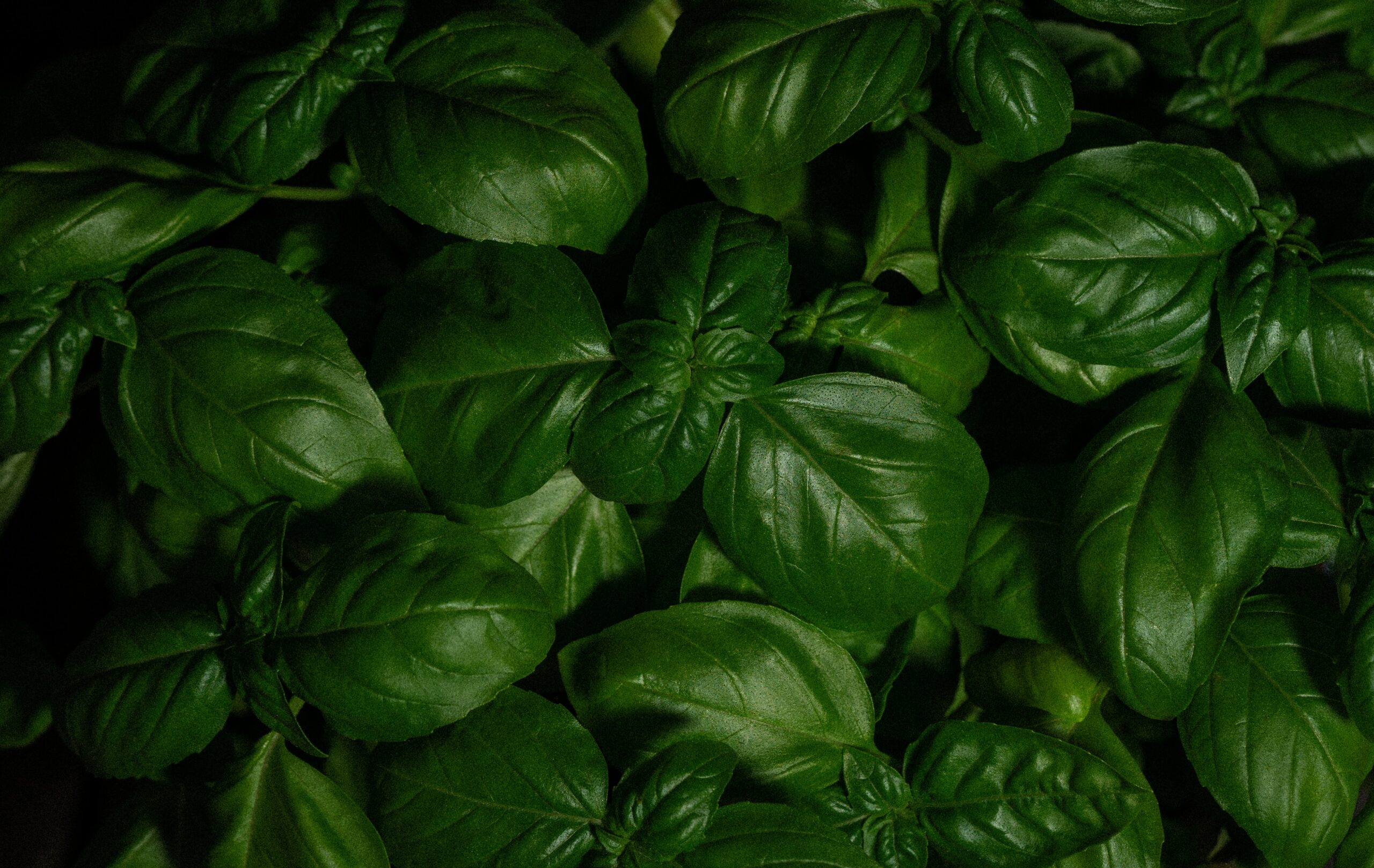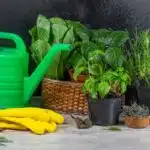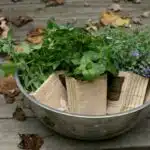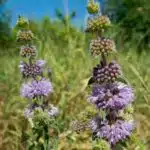Basil is a fragrant, flavorful herb that’s often used in Mediterranean, Asian and American cuisine. While it may seem daunting to attempt to grow your own at home, the truth is that basil can be a surprisingly easy plant to cultivate with just a few basics steps. Whether you have an outdoor garden or just some space on your windowsill, you can learn how to grow basil plants with a little bit of effort and dedication.
Juxtaposed against its reputation as an intimidatingly difficult plant, basil is actually incredibly simple to take care of. All it takes is a few basic steps and some consistent maintenance, and soon enough you’ll be reaping the rewards of having fresh herbs for cooking. Plus, growing your own basil can be surprisingly rewarding – no more overpaying for dried herbs from the store or settling for less-than-fresh flavor from pre-packaged options!
With the right guide and a little bit of patience, anyone can learn how to grow their own basil plants from the comfort of their home. So if you’re ready to get started on your adventure into gardening and explore all the amazing flavors that fresh herbs have to offer, read on for our guide on how to grow basil plants!
Selecting The Right Basil Plant
Choosing the right basil plant is an essential step for growing your own delicious herbs. Whether you prefer a strong, spicy flavor or something more subtle and sweet, you’ll want to select the type of basil that suits your taste. Sweet basil is a good place to start because it’s easy to grow and has an aromatic flavor, but there are many varieties available for you to explore.
No matter which type of basil you choose, make sure it is certified disease-free and free from chemical treatments. You can find seeds or plants at nurseries or garden centers; if ordering online, read reviews from other customers to ensure quality. Start with a small amount of plants so that they don’t become overcrowded in your garden.
Now that you’ve chosen the right variety of basil, the next step is preparing the soil for planting. Proper soil preparation ensures that your plants will thrive and produce delicious herbs all season long!
Preparing The Soil For Planting
Growing your own basil is a rewarding experience, and a great way to get fresh herbs for your cooking. Take Bob for example; he found himself in his backyard one sunny morning, spade in hand, ready to prepare the soil for planting.
The first step in growing basil is preparing the soil. It’s important to make sure the soil has enough drainage and that it’s not too acidic or alkaline. To do this, mix some compost into the soil and check its pH levels with a testing kit. For best results, aim for a pH between 6 and 7. Additionally, adding some fertilizer can help your plants grow strong and healthy.
It’s also important to ensure there are no weeds or other vegetation present in the area where you’re about to plant. Remove any unwanted growth by hand or use an herbicide if necessary. Once all of this has been done, it’s time to choose where you want your basil plants to go – whether it be in containers or outdoor gardens.
No matter which method you choose, ensuring that the soil is properly prepared is essential for successful growth of your basil plants. With just a few simple steps you can have fresh herbs at your fingertips!
Planting Basil In Containers Or Outdoor Gardens
The promise of a lush garden of herbs bursting with flavor and aroma is enough to make the greenest of thumbs itch with excitement. Planting basil in containers or outdoor gardens is the first step in making that dream a reality.
Like any living thing, basil needs certain conditions to thrive. To prepare for planting, it’s important to provide the right kind of soil with plenty of organic matter, such as compost or aged manure, which helps loosen clay soil and improve drainage. Also consider adding fertilizer to give your plants a nutrient boost during warm weather months.
Once your soil is ready, it’s time to plant. Basil can be planted directly into garden beds or in containers filled with potting mix. Be sure to space your plants at least 6-8 inches apart, so they get room to grow and spread out their roots. As they sprout up from the ground, you may want to stake them so they don’t topple over from the weight of new growth.
Finally, your basil plants will need regular water and fertilization throughout the growing season for optimal growth and flavor production – two important ingredients for success!
Watering And Fertilizing Basil Plants
Watering and fertilizing basil plants is an essential part of growing them successfully. To ensure your basil plant is healthy, it’s important to give it the right amount of water and fertilizer. Here are five key points to keep in mind:
Water your basil plant regularly, but don’t over-water. Ideally, you should water only when the soil is completely dry or beginning to show signs of wilting.
Fertilize your basil plants with a balanced fertilizer two or three times during the growing season. Follow the instructions on the label for how much and how often you should fertilize.
If you’re growing basil in containers, use a potting mix that has been enriched with compost or fertilizer specifically formulated for container gardening.
Don’t fertilize too much; too much can burn your plant’s roots and stunt its growth.
When using liquid fertilizer, make sure to dilute it according to package instructions before applying it around the base of your basil plant.
By following these tips, you can give your basil plants the support they need to flourish. It’s also important to be mindful of how much light and heat your plants are getting so you can adjust accordingly if necessary. With proper watering, fertilizing, and attention, you’ll be rewarded with lush, leafy herbs that will add flavor to any dish!
Pruning And Harvesting Basil
When it comes to harvesting basil, timing is key. To get the most out of your plants, you’ll need to prune them regularly and harvest the leaves before the plant flowers. In fact, research shows that harvesting basil prior to flowering can increase yields by up to 30 percent!
Here are a few tips for getting the most out of your basil: • Prune often – Trim your plants back regularly to encourage growth and keep it from flowering. • Harvest sparingly – Don’t take too many leaves at once and make sure they’re fully mature before picking. • Use what you harvest – Enjoy all that fresh basil in salads, sauces, soups or other dishes!
These simple steps will help ensure that you get the most out of your basil plants. Taking care of them requires a bit of work but doing so can make all the difference in terms of yield and flavor. And as an added bonus, these same steps can help protect against common pests and diseases. All in all, taking good care of your basil plants pays off in more ways than one!
Common Pests And Diseases Of Basil
Basil is a popular herb that can be grown in gardens and containers. It’s easy to care for, but if you don’t take the necessary steps, it can be susceptible to some pests and diseases. In this section, we’ll cover these common problems of basil so you can properly identify them and take the necessary steps to control them.
The first thing to look out for is fungal diseases such as downy mildew, powdery mildew and root rot. All of these can cause wilting, yellowing and stunted growth of the plant. To prevent these diseases from occurring, make sure to provide good air circulation and avoid over-watering your plants. If you do spot any of these diseases, remove the affected leaves immediately and treat with a fungicide or sulfur dust.
Another pest that commonly affects basil are aphids. These small insects feed on the sap of the plant, causing yellow spots on leaves and stunted growth. To get rid of aphids, spray your plants with a strong jet of water or use an insecticidal soap solution to remove them from your plants. If you’re growing basil indoors then using a natural predator such as ladybugs or lacewings can help keep the aphid population under control.
By taking preventive measures such as providing good air circulation and avoiding overwatering your plants, along with treating any identified pests or diseases quickly, you can ensure that your basil crop will remain healthy throughout its growth cycle.
Common Varieties Of Basil
Now that we’ve gone over the basics of growing basil, let’s take a look at some of the common varieties. From sweet Genovese to spicy Thai, there are plenty of delicious options for any herb gardener.
Each type of basil has its own unique flavor and aroma, so it’s important to know what you’re looking for before you start planting. For example, Italian or Sweet Basil is popularly used in pesto and other Italian dishes due to its strong flavor. On the other hand, Lemon Basil is great for adding a bright citrusy flavor to salads, soups and sauces.
If you’re feeling adventurous, consider trying out some of the more unique varieties such as Holy Basil or Cinnamon Basil. These both have distinct flavors that can add a special touch to your meals. With all these options available, it’s easy to see why basil has been beloved by culinary enthusiasts for centuries!
By getting familiar with all the different types of basil available and learning how each one tastes best when cooked, you can ensure that your dishes always turn out flavorful and delicious! With this knowledge in hand, let’s now explore the many benefits of growing basil in your garden or on your windowsill.
Benefits Of Growing Basil
Growing basil is a great way to add flavor to your meals, and it’s not just delicious – it can also be beneficial for your health. Here are 8 benefits of growing this fragrant herb:
Aromatic – Basil has a strong scent that is both refreshing and calming. The aroma of the leaves can help create a peaceful atmosphere in any space.
Low Maintenance – Basil is an easy-to-grow plant that doesn’t require much care or attention. Once you’ve planted it, all you need to do is water it regularly and keep it in a sunny spot.
Nutritious – Not only is basil packed with antioxidants and vitamins, but its strong flavor means you don’t need to use as much salt or other seasonings when cooking with it.
• Health Benefits: Basil contains compounds like eugenol, which has anti-inflammatory properties that can help relieve joint pain and reduce the risk of heart disease and stroke. It also has antibacterial properties that can protect against certain infections. • Culinary Uses: From pesto sauces to Thai curries and salads, there are countless recipes where basil adds flavor, color, and texture. Plus, you can even make tea from fresh basil leaves! • Medicinal Uses: Traditionally used in Ayurvedic medicine, basil has been shown to aid digestion, improve blood circulation, reduce stress levels, alleviate headaches, improve skin health, and provide relief from colds and other respiratory conditions.
The benefits of growing basil go beyond taste – they provide us with healthful nutrition while being low maintenance at the same time! With these numerous benefits in mind, let’s move on to discuss companion planting with basil…
Companion Planting With Basil
It’s the age-old question; how do you know if your basil is truly happy? Well, it turns out that in addition to giving your basil plenty of sun and water, it may also appreciate the company of other plants. That’s right, according to experts companion planting is a great way to make sure your basil plant is living its best life!
What is companion planting? It’s when two or more plants are planted together in order to promote growth, pest control and other benefits. When it comes to basil and companion planting, there are some great options for natural pest control and nutrient sharing. Planting tomatoes or marigolds near your basil can help protect it from pests and enhance the flavor of the basil by allowing it access to more nutrients.
If you’re looking for a way to give your basil an extra boost while keeping away pests, then companion planting is definitely worth considering. Your plant will appreciate having some friends nearby and you’ll enjoy a healthier crop as a result!
Preserving And Storing Basil
Preserving and storing basil can be a tricky process, but it’s possible to do it successfully. It’s important to consider the theories of food preservation before attempting to preserve basil. After all, preserving foods has been used by humans for thousands of years to make sure that they have access to nourishing meals even during times of scarcity.
When preserving basil, there are two main methods: drying and freezing. Drying is the most common method and involves removing moisture from the leaves so that they don’t spoil as quickly. This can be done easily at home either in an oven or with a dehydrator. Freezing is another option and can be done by simply placing washed and dried basil leaves in an airtight container or freezer bag and then storing them in the freezer. Either way, these methods will help extend the shelf life of your basil so that you can enjoy its flavor for a longer period of time.
Though every situation is unique, preserving and storing basil may be one of the best ways to guarantee access to fresh herbs throughout the year. As well as being convenient, it also offers an opportunity to capture its flavor when it’s at its peak ripeness – ensuring that each dish you make tastes just as good as if you had picked it straight from the garden!
Growing Basil In Hydroponic Systems
Growing basil in hydroponic systems is a great way to get a bountiful harvest with minimal effort. Hydroponics allows for a more controlled environment and faster growth, which is ideal for those who want to maximize their yield. Plus, it’s relatively easy to set up and maintain.
When it comes to growing basil in hydroponics, there are several options available. A basic system can be built with just a few supplies such as buckets, tubing, and pumps. It’s also possible to purchase pre-made kits with everything you need to get started. Regardless of the option you choose, the same basic principles apply when it comes to setting up your system and caring for your plants.
Once your hydroponic system is set up, you’ll need to provide the right conditions for your basil plants to thrive. This includes providing enough light and nutrients for them to grow properly. Additionally, make sure that the temperature isn’t too hot or too cold and that the humidity is at an appropriate level. With the right setup and care, you should be able to enjoy a bounty of fresh basil year round!
Moving indoors will give you even more control over your environment while still enjoying all of the benefits of hydroponics!
Growing Basil Indoors
Growing basil indoors is an exciting and rewarding experience. With the right approach, you can take advantage of the unique environment that indoor environments offer. Setting up a successful indoor basil garden requires careful planning and attention to detail.
Begin by selecting a suitable container for your basil plants. Make sure it is big enough to allow for adequate drainage and enough soil for the roots to grow into. When choosing a location for your plants, remember that they need plenty of sunlight, so choose one with direct access to natural light. Additionally, make sure the area is well-ventilated as this will help keep the air circulating around your plants.
Watering your basil regularly is key to keeping it healthy and thriving – check on the soil regularly and water whenever it feels dry. It may also be necessary to fertilize the soil occasionally in order to maintain optimal growth conditions. Finally, pruning your basil regularly can help promote healthy growth and prevent overcrowding of leaves or branches.
By following these steps, you can create a thriving indoor garden full of fragrant herbs like basil! With its versatility in culinary dishes or as an essential oil, growing this herb indoors offers many benefits for both cooking enthusiasts and DIY herbalists alike.
Common Uses For Basil
As you can imagine, there are many beneficial uses for basil. This fragrant herb has been used in many cultures for centuries as a seasoning and medicine. Not only is it delicious, but it is also incredibly healthy. In this section, we’ll explore some of the most common uses for basil, so that you can make the most of this wonderful plant.
Basil has been found to be an excellent source of Vitamin K and Calcium, making it a great way to get your daily dose of minerals and vitamins. It also contains antioxidants that can help support your immune system and protect your body from disease. Additionally, its anti-inflammatory compounds have been known to help reduce inflammation in the body. Therefore, adding basil to your regular diet can be very beneficial!
In addition to providing health benefits, basil is also great for cooking! Its unique flavor adds a depth of taste to dishes like pasta sauce and pesto. You can even use it as an ingredient in salads or sandwiches. No matter how you choose to use it, adding basil will add delicious complexity to any dish!
Using fresh basil in your cooking doesn’t just bring flavor; it also provides numerous health benefits as well! With so many uses for basil, why not make the most of this wonderful plant? Now let’s look at tips for growing a successful basil plant so you can enjoy these benefits year-round!
Tips For Growing A Successful Basil Plant
Growing a successful basil plant doesn’t have to be a daunting task. With the right preparation and a few simple tips, you’ll have your very own basil harvest in no time. Let’s dive into some of the key things to consider when it comes to growing basil.
First off, you’ll need to choose the best spot for your basil patch. Make sure it gets at least six hours of full sun each day – that’s essential for ensuring optimal growth. Basil also needs plenty of water; aim for about an inch per week during growing season and make sure the soil is well-draining so that it doesn’t become waterlogged or overly dry.
Once your seedlings are in place, care for them regularly with light pruning and fertilizing. You can also use companion planting – try planting onions and garlic alongside your basil as they help repel insect pests like aphids or whiteflies. As your plant grows taller, you might need to provide some support with sticks or a trellis, but other than that all you need is lots of TLC!
So there you have it: with these tips in mind, you can create an abundant basil crop without the stress or hassle. Now all that’s left to do is troubleshoot any common problems that may arise along the way!
Troubleshooting Common Problems With Growing Basil
Do common problems with growing basil ever leave you stumped? With the right know-how, you can troubleshoot any issue that arises and be on your way to a thriving basil plant. Let’s take a look at some of the most common problems and how to solve them.
First, let’s talk about dealing with pests. If aphids or whitefly are causing trouble for your basil, the best thing to do is introduce beneficial insects such as ladybugs or lacewings into your garden. These insects will help keep populations of harmful pests in check and keep your basil healthy.
If diseases are damaging your basil plants, make sure you’re using sterile soil and watering at the base of the plant. Additionally, it’s important to look out for signs of diseases like downy mildew or powdery mildew and remove affected plants promptly. Taking these precautions can help protect your basil from disease outbreaks in the future.
Finally, if temperatures become too hot or cold for your plant, consider covering it up with a lightweight cloth or plastic sheeting when extreme temperatures are forecasted. Adding extra protection during harsh weather conditions can ensure that your basil has the best chances of survival.
With these tips in mind, you’ll be equipped to tackle any issues that may arise while caring for your basil plant!
Frequently Asked Questions
How Long Does It Take For Basil To Germinate?
It’s the age-old question: how long does it take for basil to germinate? Jumpstarting your herb garden can be an exciting endeavor, but it often takes a bit of patience to get things going. When it comes to growing basil, you’ll need to set aside a bit more time than with other plants as germination could take up to two weeks.
To get your basil sprouting, it’s important to start off on the right foot. Preparing the soil and planting appropriately is key. Loamy soil with good drainage is ideal for basil growth, so make sure you have that in place before sowing your seeds. As the saying goes, ‘Rome wasn’t built in a day’, and neither will your herb garden.
Once planted, all you have to do is wait and watch as nature works its magic. After about two weeks of tending and watering, you should start seeing some small green sprouts emerging from the soil – like little miracles! It’s truly amazing how much life can come out of one seed. With a little TLC and some faith in Mother Nature, you’ll soon see your hard work pay off in the form of lush green foliage!
How Often Should I Water My Basil Plant?
Watering basil plants is like giving them a hug. It’s a way of showing love, and a necessary step in ensuring their growth. So, how often should you water your basil?
The key to successful watering is moderation. While it’s true that basil loves moisture, too much water can be just as detrimental as not enough. You’ll want to check the soil regularly before deciding if your plant needs to be watered. If the top inch feels dry, then it’s time for some hydration. Otherwise, let it be until the soil dries out again.
To make sure your basil gets the perfect amount of water, try using an irrigation system like a self-watering pot or hydroponics kit. These systems will help you maintain consistency with your watering schedule and ensure that your plant receives the optimal amount of moisture at all times. With proper care and attention, you’ll have a thriving herb garden full of vibrant basil plants!
What Is The Best Temperature To Grow Basil?
Basil is an incredibly popular and versatile herb, used in a variety of cuisines around the world. According to the National Gardening Association, about 30% of all home gardens in the United States contain basil plants. For those looking to cultivate their own basil, temperature plays an important role in its growth.
When it comes to growing basil, temperatures between 70°F-85°F are ideal. If temperatures go above 90°F, basil can be prone to bolting, which is when the plant prematurely goes into flower production instead of leaf production. On the other hand, if temperatures dip too low – ideally below 60°F – then basil may not even germinate at all.
Therefore, it’s important to find a happy medium that allows your basil plants to thrive without any issues. You should also avoid exposing your plants to any sudden changes in temperature or too much direct sunlight for prolonged periods of time. With these tips and the right amount of care and attention, you can enjoy fresh homegrown basil year-round!
What Are The Best Companion Plants To Grow With Basil?
Did you know that basil is the most popular herb in the world? It’s no wonder, as it adds a unique flavor to any dish. But what are the best companion plants to grow with basil? Let’s take a closer look.
When it comes to companion planting, there are many plants that work well with basil. Tomatoes, peppers, eggplants, and marigolds are four of the most popular companions for growing basil. All of these plants can help provide shade for your basil and create an environment for healthy growth. They also all thrive in similar conditions: sunny, warm climates with plenty of water and regular feeding.
Other great companion plants for growing basil include oregano, rosemary, chives, and garlic. These herbs can help fend off pests that may be attracted to your basil plants, and their strong aromas will make your garden smell amazing! You can also plant nasturtiums around your basil plants to attract beneficial insects such as ladybugs and lacewings.
Companion planting is a great way to create a thriving garden full of robust herbs and vegetables. With some careful planning, you can create an environment where everyone grows happily together! So if you’re looking to add some fragrant herbs to your garden this year, consider adding some basil along with its perfect companions!
What Are The Best Ways To Store Basil?
Storing basil can be a tricky task since the herb is highly perishable. But with a few simple steps, you can keep your basil fresh and flavorful for longer. Let’s take a look at some of the best ways to store basil so that it stays fresh and fragrant.
First, if you plan to use your basil within a day or two, the best way to store it is in the refrigerator. Place the basil leaves in an airtight container and make sure they are dry. This will help preserve their flavor better than if they were stored in a damp environment. Additionally, you can wrap them loosely in a damp paper towel before refrigerating them to help keep them from drying out too quickly.
If you want to store your basil for longer periods of time, freezing is the way to go. Start by washing and drying the leaves thoroughly and then place them on a baking sheet lined with parchment paper or wax paper. Put this in the freezer for about an hour before transferring them to an airtight container or zip-top bag for storage. You can also chop up the leaves before freezing for easy use later on when cooking dishes such as soups or sauces.
No matter how you plan to store your basil, it’s important to remember that freshness is key! Keeping your herbs dry and away from direct sunlight will help ensure that they stay as fragrant and flavorful as possible for as long as possible. So don’t delay – start storing your basil today!
Conclusion
Basil is a wonderfully fragrant and versatile herb that can be used to liven up any dish. With its helpful hints, caring for basil is sure to become second nature to gardeners of all skill levels. Whether you’re growing it indoors or out, you’ll be rewarded with a vibrant and flavorful addition to your kitchen arsenal.
Growing basil can be an incredibly rewarding experience. Not only is the process relatively easy but the results are far more satisfying than any store-bought herbs could ever be. Watching the plant grow from its small seedling form into a bushy pot of deliciousness is like witnessing a magical transformation before your very eyes!
Once you learn how to grow basil, you’ll never want to go back to buying it from the store again. All your dishes will suddenly become infused with a new level of flavor that will make them truly stand out from the crowd. It’s no exaggeration when we say that growing basil is one of the best decisions you can make for yourself and your garden!





























